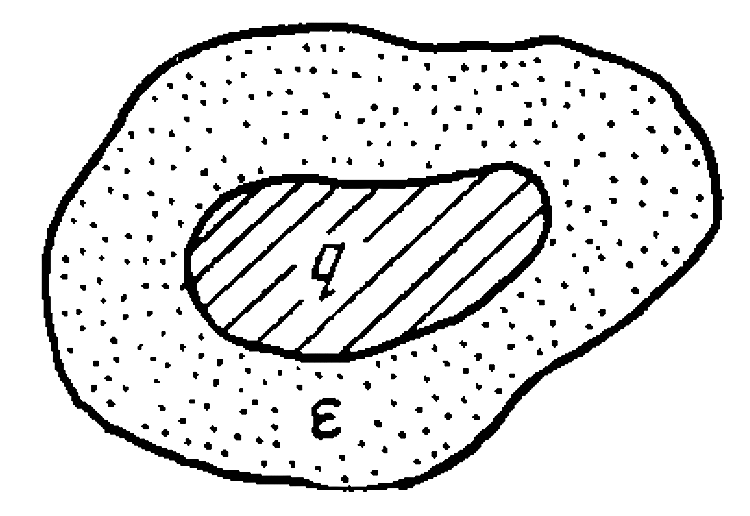A point charge q si located on the plane dividing vacumm and infinite uniform istropic dielectric with permittivity eposilon. Find the moduli of the vectors D and E as well as the potentail φ as funtions of distance r from the charge q.
Ep=q→r14πε0r31+q→r24πr32ε0,P in 1
Er=q→r14πε0r31,P in 2
where q''=2qε+1,q'=q''−q
In the limit →l→0
−→Ep=(q+q')→r4πε0r3=q→r2πε0(l+ε)r3, in either part,
Thus Ep=q2πε0(l+ε)r2
φ=q2πε0(l+ε)r
D=q2πε0(l+ε)r2×{1 in vacumε in dielectric

Topper's Solved these Questions
- ELECTRODYNAMICSBOOK - IE IRODOV, LA SENA & SS KROTOVCHAPTER - ELECTRODYNAMICSEXERCISE - Electric Capacitance - Energy Of An Electric Field
46 Videos
- ELECTRODYNAMICSBOOK - IE IRODOV, LA SENA & SS KROTOVCHAPTER - ELECTRODYNAMICSEXERCISE - Electric Current
72 Videos
- ELECTRODYNAMICSBOOK - IE IRODOV, LA SENA & SS KROTOVCHAPTER - ELECTRODYNAMICSEXERCISE - Motion Of Charged Particle In Magnetic Field
36 Videos
- ELECTRICITY AND MAGNETISMBOOK - IE IRODOV, LA SENA & SS KROTOVCHAPTER - ELECTRICITY AND MAGNETISMEXERCISE - All Questions
6 Videos
- ELECTROMAGNETISMBOOK - IE IRODOV, LA SENA & SS KROTOVCHAPTER - ELECTROMAGNETISMEXERCISE - All Questions
24 Videos
Similar Questions
A point charge q is located at the centre of a ball made of uniform istopic dielectric with permittivity epsilon. Find the polarizaion P as a function of the radius vector r relative to the centre of the system, as well as the chagre q' inside a sphere whose radius is less than radius of the ball.
View SolutionHalf the space between two concentricv elecrodes of a sphereical capacitor is filled , as shwon in Fig, with unifrom istropic dielectric with permittively ε. The charge of the capacitor is q. Find the magnitude of the electric field strength between teh electrodes as a function of distance r from the curvature centre of teh electrodes.

View Solution
Knowledge Check
Electrostatic potentail V at point, distant r from a charge q varies as
Aq/r2Bq2/rCq/rDq2/r2
A point charge q is located in vacumm at a distance l from the plane surface of a unifrom isotropic deilectric filling up all the half-space. The permittivity of the dielectric equals ε. Find :
(a) the surface density of the bound chagres as a function of distanc e r from the point charges q'. anayse the obtained result at l−.0,
(b) the total bound charge on the surface of the dielectric
View SolutionA point charge q is located at a distance l from an infinite tonducting plane. Find the interaction energy of that charge with chose induced on the plane.
View SolutionA small conducting ball carrying a charge q is located in a uniform an infinite boundary plane between the dielectrics and vacumm. Find the surface density of the bound chagres on the boundary plane as a function of distance r from the ball. Analysse the obtained result for l→0.
View SolutionA conductor of orbitrary shape, carrying a charge q, is surrounded with uniform dielectric of permittivity ε (Fig).

Find the total bound charges at the inner and outer surfaces of the dilectric.
View SolutionA half-space filled with uniform istropic dielectrics with permittivity ε has the conducting boundary plane. Inside the dielectric at a distance l from this plane, there is a small metal ball possensing a charge q. Find the surface density of the bound chagres at the boundary plane as a function plane as a function of distance r from the ball.
View SolutionAn infinite plane of uniform dielectric with permittivity ε is uniformly charged with extraneous chagre fo space density ρ. The thickness of the plate is equal to 2d. Find:
(a) the magnitude of the electric field strength and the potential as functions of distance l from the middle point of the plane.(where the potential is assumed to be equal to zero), having chosen teh x coriditnate axis perpendicular to the plate, draw the approximate plots of teh projection Ex(x) of the vector E and the potentail φ(x), plots fo the projection Ex(x) of the vector E adn the potential φ(x),
(b) the surface and space denstites of the bound charge.
View SolutionA point charge q is located between two mutually perpendicular conducting half-planes. Its distance from each half-plane is equal to l. Find the modulus of the vector of the force acting on the charge.
View Solution
